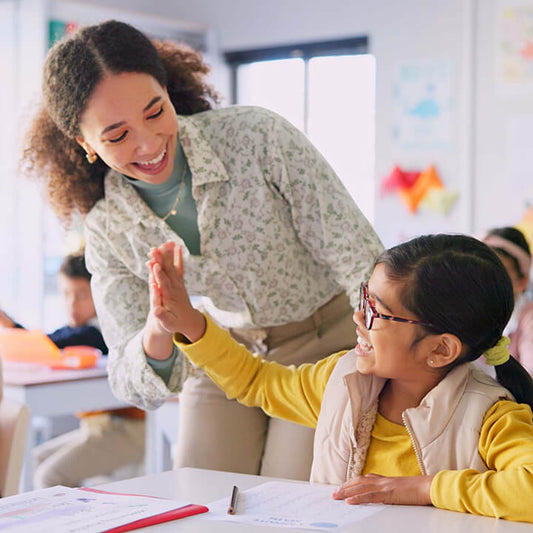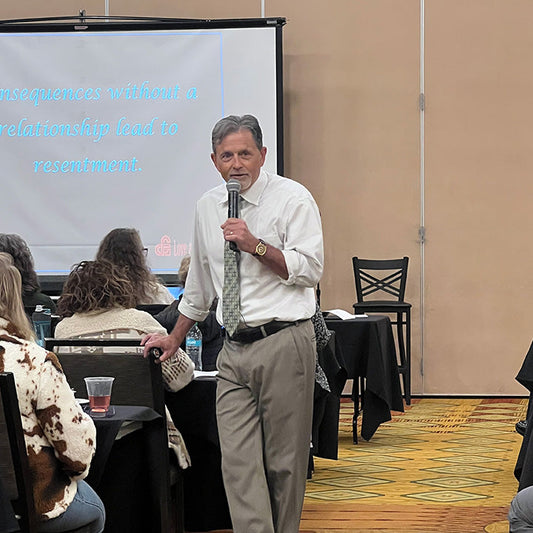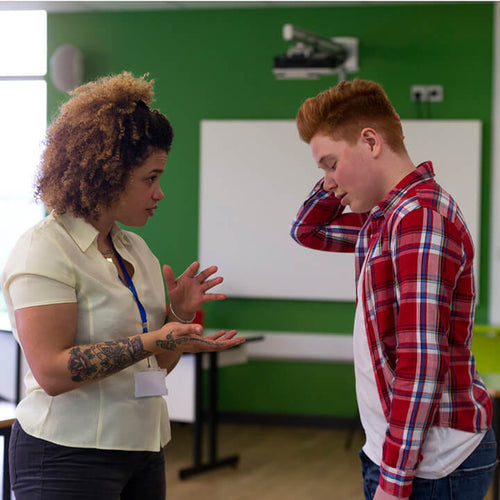In today’s education system, it’s easy to get swept up in test scores, academic benchmarks, and curriculum standards. But some of the most meaningful learning experiences don’t come from worksheets or exams. As educators, we have the profound opportunity to nurture the whole child—not just academically, but socially and emotionally. Two foundational life skills we can help develop are empathy and respect.
These core values aren’t just “nice to have”—they are essential for cultivating a supportive classroom culture where students feel safe, seen, and valued. When these values are consistently reinforced, children are more likely to grow into compassionate, emotionally intelligent, and responsible individuals.
At Love and Logic, our philosophy centers on building strong teacher-student relationships rooted in mutual trust, empathy, and healthy boundaries. Rather than relying on lectures or scripted lessons about character, we believe children learn best through modeling and connection.
When students consistently witness adults demonstrating empathy, using respectful communication, and handling challenges with emotional maturity, they begin to internalize those behaviors as their own. It’s not about teaching values—it’s about living them.
Before we dive into practical tools for nurturing empathy and respect in the classroom, let’s take a moment to reflect on why these values are so critical—not just for behavior management, but for lifelong success and well-being.
Why Empathy and Respect Matter in the Classroom?
Empathy is the ability to understand and share the emotions and experiences of another person. In a classroom setting, empathy helps students form meaningful social connections, increasing their capacity to support one another, collaborate constructively, and avoid harmful behaviors such as bullying or exclusion. When students develop and consistently practice empathy, they become more capable of navigating interpersonal dynamics, resolving peer conflicts, and cultivating strong, emotionally intelligent relationships in the future.

Respect is equally essential. A respectful classroom climate is one where students feel emotionally safe, seen, and affirmed. Respect involves acknowledging the intrinsic value of every individual’s voice, emotions, and contributions. In this kind of inclusive learning environment, students are encouraged to communicate openly without fear of criticism, and individual differences are embraced as strengths. Such an atmosphere nurtures emotional security and supports student engagement, motivation, and academic achievement.
Together, empathy and respect create the cornerstone of a positive, inclusive, and emotionally supportive learning environment. They are key components in shaping a classroom culture where students can flourish not only as scholars but also as socially responsible individuals.
So how do we, as educators, ensure that empathy and respect are embedded in our teaching practices? Here are some suggestions for weaving these essential values into the fabric of daily classroom life.
1. Model Empathy and Respect Every Day

Children learn by observing the behavior of the adults around them. If we want students to embrace empathy and respect, we must model these values consistently in our interactions with them.
Start by showing genuine interest in your students as individuals. When a student is upset or frustrated, take time to listen carefully and respond with empathy. For example, you might say, “I can see that you’re feeling overwhelmed right now. Let’s work through this together.” This demonstrates that you care about their feelings and are committed to helping them navigate their emotions in a positive way.
Respect should be a cornerstone of every interaction in the classroom. Treat each student with kindness, regardless of their behavior or academic performance. Avoid making judgments based on first impressions or preconceived notions. When students see you consistently showing respect to others, they are more likely to treat their peers with the same consideration.
Modeling empathy and respect isn’t just about how you treat students, though. It’s also about how you respond to conflicts or challenging situations. When a disagreement arises in the classroom, approach the situation with empathy. Instead of immediately doling out consequences, try to understand the perspectives of everyone involved and seek a solution that benefits all parties.
Related Article: Using and Modeling Empathy
2. Respond to Misbehavior with Empathy

It’s easy to become frustrated when a student acts out or behaves disrespectfully. However, we encourages educators to respond to misbehavior from a place of empathy rather than anger or frustration. This approach not only helps resolve the immediate issue but also contributes to the long-term development of the student’s emotional intelligence.
When frustrated by inappropriate behavior, teachers using Love and Logic will delay consequences so they can calm down and consider an appropriate course of action. At a later time, they can speak privately with the student and say something like, “I notice you’re having a hard time today. Let’s talk about what’s going on.” By doing this, you create a safe space for the student to express their emotions and work through their difficulties.
3. Create a Culture of Mutual Respect

Building a culture of mutual respect starts with the way we treat one another every day. Set the tone for your classroom by being consistently positive, inclusive, and encouraging. Make it clear from the beginning that every student’s voice matters, and that their contributions are valued.
Encourage students to express their ideas and opinions and ensure that they do so respectfully. When students feel that their thoughts and feelings are appreciated, they are more likely to extend that same respect to their peers.
Classroom culture is shaped not only by how students interact with one another but also by how they perceive authority figures. Your own actions as a teacher play a significant role in setting the standard for respectful behavior. By maintaining a calm, respectful demeanor even in difficult situations, you model the kind of behavior you want to see in your students
It’s also important to acknowledge and celebrate acts of respect and empathy when you see them. When a student goes out of their way to help a classmate or shows kindness in a challenging situation, take a moment to recognize their efforts privately. This not only reinforces the behavior but also shows other students what empathy and respect look like in action.
By making reflection a regular part of your classroom routine, you help students become more mindful of their behavior and more intentional about treating others with kindness and respect.
4. Be Patient and Consistent

Fostering empathy and respect in the classroom is not a one-time event—it’s an ongoing process that requires patience, consistency, and dedication. Students won’t always get it right, and that’s okay. What’s important is that they continue to learn and grow over time.
Be patient with your students as they work to develop these skills. Remember that every small step forward is progress, and celebrate those moments when students demonstrate empathy and respect in their interactions. Over time, these small steps will accumulate, helping to build a classroom culture where kindness, understanding, and respect are the norm rather than the exception.
Consistency is key to fostering empathy and respect. Be clear in your expectations and follow through on them regularly. When students know that you are committed to maintaining a respectful and empathetic classroom environment, they are more likely to embrace those values themselves. Even when challenges arise, sticking to your principles will help reinforce the importance of these core values in the minds of your students.
Moreover, maintaining consistency in how you respond to both positive and negative behaviors is crucial. When students see that empathy and respect are not just occasional ideals but constant expectations, they’ll understand that these behaviors are foundational to the way the classroom operates. By being patient and consistent, you help students internalize these values as part of their own moral compass.
Conclusion: The Long-Term Impact of Fostering Empathy and Respect
When we emphasize empathy and respect in our classrooms, we’re doing far more than helping students succeed academically—we’re giving them the tools they need to build meaningful, successful lives. Empathy and respect lay the foundation for strong relationships, effective communication, and a positive attitude towards themselves and the world around them. These values promote emotional intelligence and social responsibility, helping students navigate challenges with resilience and grace.
As educators, we have the privilege of shaping not just the minds of our students, but their hearts as well. By fostering a classroom environment where empathy and respect are celebrated and practiced every day, we help guide our students towards becoming compassionate, thoughtful, and responsible individuals who are equipped to make a positive impact on the world.
The lessons of empathy and respect will extend far beyond the classroom walls. For more resources check out Home and School Strategies for Creating Respectful, Responsible Kids. Students who learn to understand and care for others in meaningful ways are more likely to carry those values into adulthood. Whether they become leaders in their communities, professionals in their chosen fields, or simply kind-hearted friends and family members, the seeds of empathy and respect we plant today will bear fruit for years to come.
Ultimately, the legacy of a Love and Logic classroom isn’t just academic achievement—it’s a generation of young people who understand the importance of kindness, compassion, and respect for all. These are the qualities that will enable them to thrive in a rapidly changing world and to contribute to the well-being of others in lasting, meaningful ways.
Isn’t that what we all want for our students?
Thanks for reading!
The Love and Logic Team


























